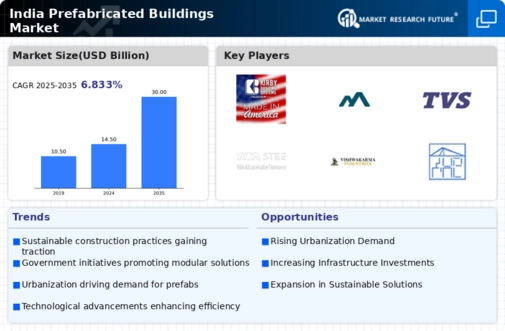Rising Urban Population
The rapid urbanization in India is a critical driver for the prefabricated buildings market. With an urban population projected to reach 600 million by 2031, the demand for housing and infrastructure is escalating. This surge necessitates innovative construction solutions that can be deployed quickly and efficiently. Prefabricated buildings offer a practical response to this challenge, allowing for the swift erection of residential and commercial structures. The ability to construct buildings in a fraction of the time compared to traditional methods is particularly appealing in densely populated urban areas. As cities expand and the need for housing intensifies, The prefabricated buildings market is poised to play a pivotal role in addressing these challenges. It has the potential to capture a significant portion of the construction market in urban India..
Technological Integration
Technological integration is reshaping the prefabricated buildings market in India. Advancements in construction technology, such as Building Information Modeling (BIM) and modular construction techniques, are enhancing the efficiency and quality of prefabricated structures. These technologies facilitate precise planning and execution, reducing errors and construction time. The integration of smart technologies into prefabricated buildings is also gaining traction, with features like energy-efficient systems and automated controls becoming more prevalent. As the construction industry embraces digital transformation, the prefabricated buildings market stands to benefit from improved project management and reduced costs. This trend suggests a future where technology-driven solutions dominate the market, potentially leading to higher adoption rates among builders and developers.
Environmental Sustainability
Environmental sustainability is increasingly becoming a focal point for the prefabricated buildings market in India. As awareness of climate change and resource depletion grows, there is a pressing need for construction methods that minimize environmental impact. Prefabricated buildings, which often utilize sustainable materials and generate less waste during construction, align well with these environmental goals. The market is witnessing a shift towards eco-friendly practices, with many companies adopting green certifications and sustainable building standards. This trend not only appeals to environmentally conscious consumers but also positions the prefabricated buildings market as a leader in sustainable construction. As regulations around sustainability tighten, the market may see a surge in demand for prefabricated solutions that meet these new standards, potentially reshaping the future of construction in India.
Cost Efficiency in Construction
The prefabricated buildings market in India is experiencing a notable shift towards cost efficiency in construction. With rising labor costs and material prices, prefabricated solutions offer a more economical alternative. By utilizing off-site manufacturing, projects can be completed faster, reducing labor expenses by approximately 20-30%. This efficiency not only lowers overall project costs but also minimizes waste, aligning with the growing demand for sustainable practices. As developers seek to optimize budgets, the prefabricated buildings market becomes increasingly attractive, particularly for large-scale projects such as residential complexes and commercial spaces. The ability to deliver high-quality structures at a lower cost positions prefabricated buildings as a viable solution in a competitive market, potentially capturing a larger share of the construction industry in India.
Government Initiatives and Policies
Government initiatives in India are significantly influencing the prefabricated buildings market. Policies aimed at promoting affordable housing and infrastructure development are creating a favorable environment for prefabricated construction. The Pradhan Mantri Awas Yojana (PMAY) scheme, for instance, encourages the use of innovative building technologies, including prefabrication, to meet housing demands. This initiative aims to provide housing for all by 2022, which has led to increased investments in the prefabricated buildings market. Furthermore, the government's focus on smart cities and urban development projects is likely to drive demand for efficient construction methods. As these policies continue to evolve, they may further stimulate growth in the prefabricated buildings market, attracting both domestic and international players to invest in this sector.


















Leave a Comment